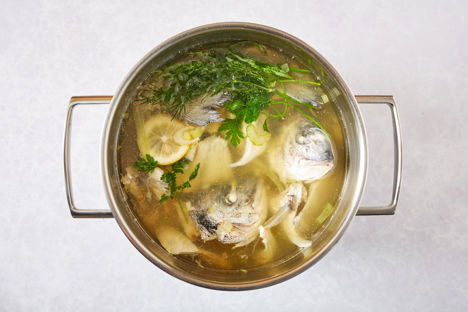Fish stock (or fumet as it’s known when concentrated) is one of the quickest, freshest, most fragrant stocks out there, and it is of course very resourceful, sustainable and satisfying to get use out of every part of the animal you’re eating.
As with all stocks, it’s a good idea to make a big batch and freeze down portions, so you always have some to hand. The recipe below is for a big batch but you can of course scale down the amounts if you want to make a small batch to use straight away.
If you are not using surplus bones from fish you have filleted yourself, ask your fishmonger for a kilo of bones – they’ll be very cheap (or maybe even free). You must only use the bones of white fish; bass, cod and flat fish are good to use. Bones of oily fish such as salmon, mackerel or tuna are too fatty and will make your stock greasy and unpleasant. The fish bones must be cleaned of any blood and gills as these will impart a nasty, bitter taste and cloud up your stock. Fish heads add a lot of flavour and contain a lot of gelatine which will give body to your stock, but make sure they are thoroughly cleaned (and always remove the gills). A good way of cleaning the bones is to run them under a cold tap and leave them to soak in the water to allow impurities to float the surface (which you can then skim and discard).
Traditionally the vegetables used to make fish stock are fennel and celery, along with aniseed herbs like tarragon and dill. Carrots tend to be avoided, as they discolour the stock. To get the most out of your vegetables chop them nice and finely, as this gives them a larger surface area when frying them off, releasing more of their flavour. For extra umami and a natural taste of the sea, throw in a sheet of kombu seaweed.
Be careful when seasoning fish stock – if you intend on reducing it down for a sauce do not add any salt until right at the end, as the saltiness will intensify and may become overpowering. If you're using the stock straight away without reducing, however, season as normal.
The recipe below makes around 1lt of stock.
Metric
Imperial
- 1kg fish bones, chopped down into 5cm pieces and cleaned
- 1 leek, white parts only, chopped
- 1/2 fennel, chopped
- 1 stick of celery, chopped
- 1 small onion, chopped
- 1/2 garlic bulb
- 500ml of white wine
- 6 white peppercorns, (you can also use pink peppercorns for a more floral flavour)
- 1 tsp fennel seeds
- 1 sheet of kombu, (optional)
- 2 bay leaves
- parsley stalks
- 1 handful of dill
- 1 handful of tarragon
- 2 slices of lemon
How to use fish stock in cooking
A top-quality fish stock is essential to many of the great seafood dishes out there – from the famous French king of soups bouillabaisse to creamy smoked haddock chowder, seafood paellas or a nicely spiced kedgeree. It is also used as a base for sauces; whisk stock into a bubbling roux of flour and butter to make a velvety fish velouté which will take your fish pie to the next level. As one of the five French ‘mother sauces’, fish velouté is a base for various ‘daughter sauces’ such as sauce Bercy which is flavoured with white wine, lemon and fresh parsley. Another is sauce Normande, which sees fish velouté enriched with egg yolks, butter and cream and is a popular accompaniment to mussels.
Restaurants often make whole vats of stock to reduce down into sauces. A stock reduced by half is known as demi-glace (demi meaning half in French), and a stock reduced by 80–90% is called a glace. Reducing the stock intensifies flavour and naturally thickens it (without having to use any kind of thickening agent). Turning fish stock into a glace is also a good way of storing your stock; once it's reduced right down it should solidify as it cools. You can then portion the glace into ice cube trays to keep in the freezer. By doing this you're essentially creating your own high-quality stock cube; simply dissolve the glace in water to turn it back into fish stock.
A fish glace is a great base to a simple pan sauce to accompany a piece of fish; whisk in some chilled butter, season with lemon juice and finish with fresh herbs or even some brown shrimp or clams. The intense flavour means a little goes a long way, and the resulting taste is far better than anything you can buy in the shops.
Get in touch
Please sign in or register to send a comment to Great British Chefs.


